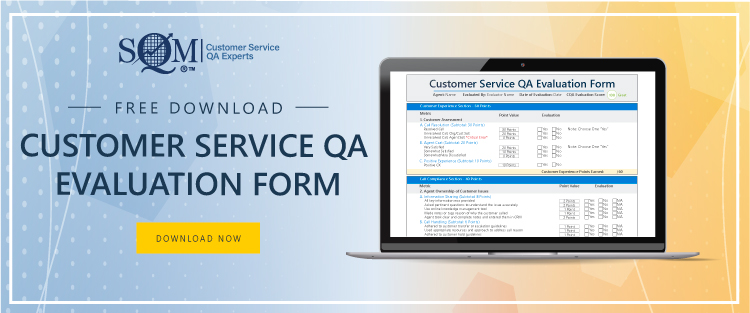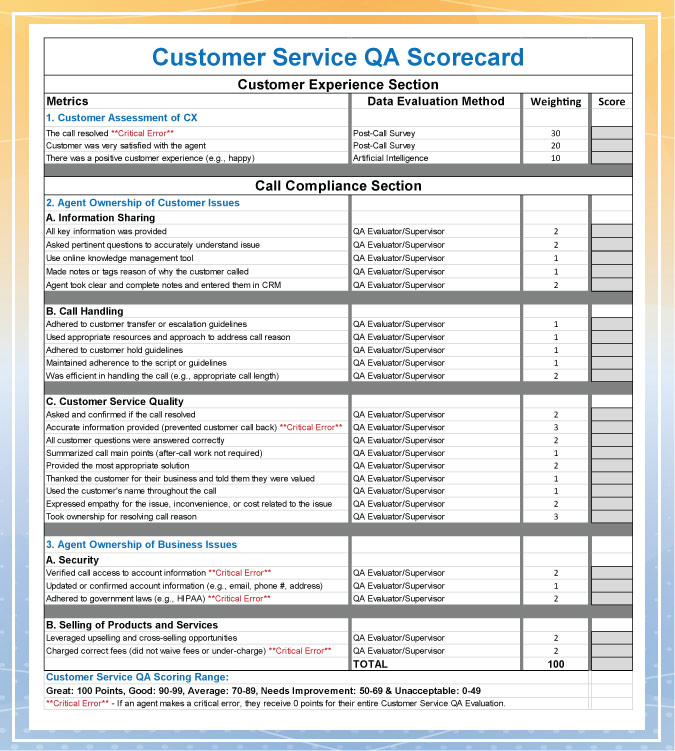What Is Customer Service QA?
Quality assurance (QA) refers to the agent and call center support provided to customers before, during, and after they purchase and use a company's products or services. Call centers use their QA program to evaluate performance for their goals (e.g., customer service, sales, costs, compliance).
What makes customer service QA unique is for the same call, the customer service QA method evaluates an agent using a post-call customer survey and call compliance metrics to assess call quality. Therefore, customer service QA is considered a holistic view of customer interaction using a call center.
When a call center's primary goal is to improve customer experience (CX), they tend to be more interested in utilizing a customer service QA method. The main reason is that customer service QA uses a 360-degree multi-rater approach (e.g., customers, QA evaluators, and artificial intelligence) to measure customer service, provide agent feedback and coaching, and proven track record for improving CX.
For companies to succeed in delivering great CX, they must achieve high customer service QA standards. Monitoring agent customer service QA can help a call center achieve consistently high-quality interactions with your callers. Call centers that can get customer service QA correct can positively differentiate their company from competitors, reduce costs, win more referrals, and have higher profitability.
Furthermore, SQM's CX research shows that 93% of customers expect their call to be resolved on the first call. Also, For every 1% improvement in FCR, there is a 1% improvement in customer satisfaction. Therefore, you can strongly argue that customer service QA can be defined as meeting or exceeding customer expectations based on achieving First Call Resolution (FCR) and high Customer Satisfaction (Csat).
Why Is Customer Service QA Important?
Most importantly, the customer service QA method has a proven track record for improving Csat. In addition, there are many benefits to achieving high customer service QA, such as enhancing your company's brand image and increasing revenue and profitability.

If you don't measure customer service QA regularly, you will not understand where the business outcome opportunities are for improving FCR and Csat.
Moreover, the agent's ability to deliver great customer service QA can determine if customers will continue to do business with the company. For example, 95% of customers will continue to do business with a company because they have experienced great CX interacting with an agent. Conversely, 88% of customers have stopped doing business with a company because of poor call center customer service. In many cases, the difference between a customer staying or leaving is the agent's ability to deliver great customer service.
Comparing Csat Based On QA Scoring Method
SQM group has conducted hundreds of quality assurance case studies with leading North American company call centers. SQM's research shows that a whopping 81% of agents' QA scores did not correlate with Csat resulting from traditional QA scorecard evaluations.
The low correlation between traditional QA and Csat scores is because the wrong metrics and weighting used to evaluate the call and the customer's viewpoint (e.g., post-call survey) is not used as part of the QA evaluation of the call.
In addition, with a traditional QA method, a QA evaluator or supervisor listens to the calls and evaluates the customer's experience. Regardless of the metrics used, weighting, or the employee who conducts the quality assurance evaluation, what remains evident is that a call center employee is judging the customer's experience, not the customer's.
Conversely, the customer service QA scorecard Csat correlates highly to QA scores.
The main reason for the high Csat and QA score correlation is that the QA evaluation form includes CX and call compliance metrics. A customer judges CX via a post-call or email customer survey and artificial intelligence, and a supervisor or QA evaluator evaluates the call compliance metrics. Furthermore, CX metrics are weighted higher than call compliance metrics.
The bottom line is that the customer service QA scorecard correlations show when a Csat score is high or low, and so is the QA score. On the other hand, when the Csat score is low, so is the QA score. Having the customer evaluate their experience when interacting with a company's call center is considered an outside-in approach. Nevertheless, it can be a valuable practice for ensuring the company is customer-centric in the way it operates.
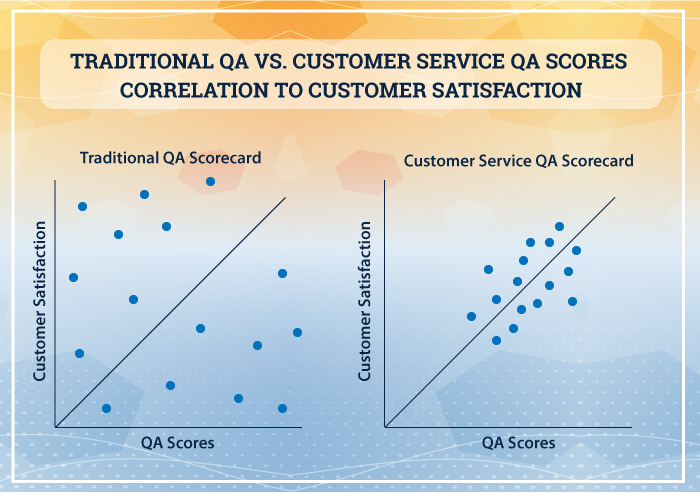
How Is Customer Service QA Different From Traditional QA?
Again for the same call, the customer service QA evaluates a call using both customer survey and call compliance metrics to assess call quality. Furthermore, one of the most significant differences is customer service QA uses a 360-degree feedback multi-rater approach (e.g., customers, QA evaluators, and artificial intelligence) to measure QA and provide agent feedback.
Conversely, in most cases, traditional QA uses only one rater approach to measure and provide agent feedback. In addition, the most effective customer service QA 360-degree feedback approach provides agents with insights based on behaviors they demonstrated on a call that multi-raters could see better than just one rater.
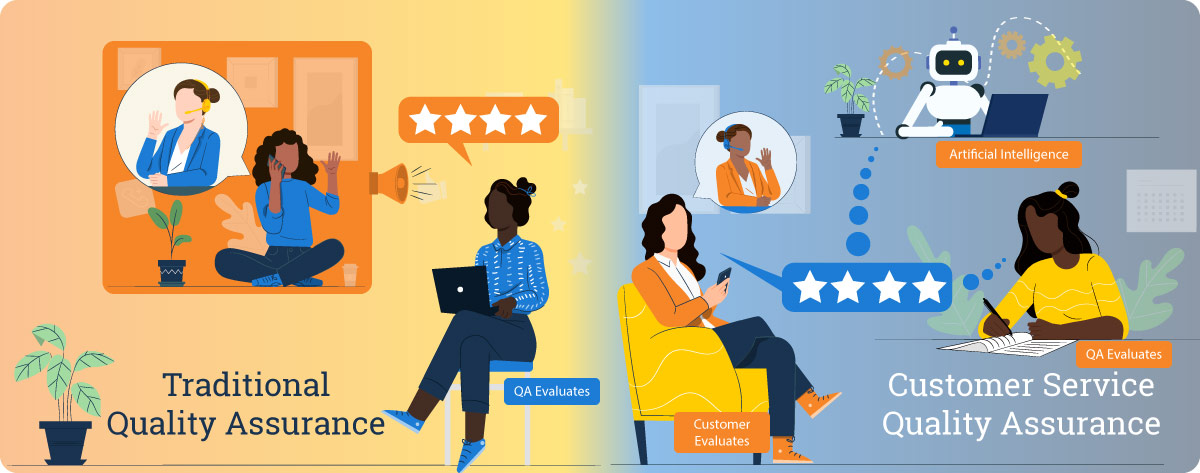
How To Create a Customer Service QA Evaluation Form
The information below is an example of a customer service QA form with a proven track record for improving CX while ensuring that call compliance is adequately managed. We believe the customer service QA form example we share can be helpful to call centers to create a customer service QA form to improve CX and call compliance.
Customer service QA evaluation form is only as effective as the metrics used in the scorecard and who evaluates it. A badly designed QA form and limited data capturing sources used are the number one reason traditional QA scores correlate poorly to Csat.
However, it is common to see call centers using traditional QA forms that have positively impacted call compliance metrics. It makes you wonder if the call center goals are more geared toward the company's needs than the customer's.
Thus, if the goal is to improve customer service, call center managers must transform their current QA evaluation form and scorecard by using different metrics, weighting, and data-capturing methods. So let's start by discussing creating a customer service QA form.
Creating An Effective Customer Service QA Form in 3 Steps:
1. Determine Your Customer Service QA Goals and Metrics
To determine if your QA program is successful, you need to decide on your customer service goals (e.g., customer service, sales, costs, compliance) and related metrics to evaluate if your agent and call center obtained your goals. Furthermore, each agent, team, and line of business (LoB) should have specific customer service QA goals and corresponding metrics based on their performance and the call center expectations.
Once you have determined agent, supervisor, LoB, and call center goals, they need to be converted to metrics that can be measured at the agent, team, and LoB levels.
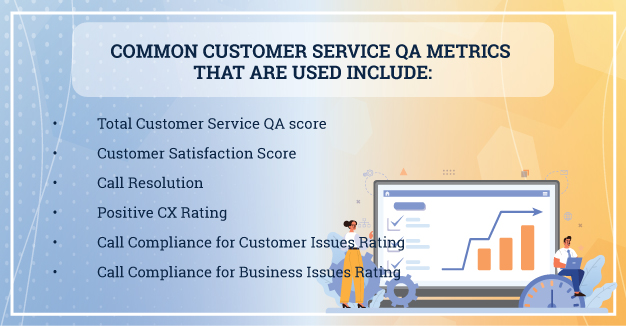
Agent goal and metric target setting should be a collaborative approach. If the agent is not engaged in the goal and target setting, they are likely not committed to achieving the Csat performance goal. Therefore, the agent goal and associated metric target must be agreed upon to ensure commitment. In addition, the goal and related metric target must be attainable.
For example, a conservative Csat (top box response) score improvement goal is 1% to 2%, a moderate Csat improvement goal is 3% to 4%, and an aggressive Csat improvement goal would be 5% or more. Unfortunately, only 5% of SQM client call centers achieve a 5% increase in overall Csat annually.
Once the agent goal and the metric used to measure performance have been decided and agreed upon, you are ready to discuss and develop an action plan to achieve the goal.
2. Determine Your Customer Service QA Metrics and Weighting
Deciding the right customer service metrics and weighting for your QA form can be challenging, controversial, and time-consuming. However, if your goal is to improve customer service, it is time to consider new QA metrics and the weighting of metrics because the focus on call compliance metrics has been less effective in improving Csat. FCR and Csat are considered by most experts as the best metrics for measuring customer service.
We believe the QA evaluation form should include a post-call survey and call compliance data from the same call to ensure a 360 feedback holistic view of the agent's customer service. In addition, the 360 feedback provides insights into the company's ability to deliver great CX judged by the customer and the QA evaluator.
We recommend that the customer service QA evaluation form include a customer experience section (e.g., call resolved, Csat, and positive CX) with most of the available points allocated to this section (see QA scoring form). The CX metrics determine whether the inquiries or problems are resolved, CX, and are judged by the customer.
Customer service QA uses post-call phone or email customer survey feedback from an independent third-party survey vendor or in-house survey methodology to determine whether the call was resolved and customer satisfaction was achieved. Customer service QA calls that are evaluated are based on customers who called the call center and completed a survey.
In addition, we recommend a call compliance section (e.g., For Customer Issues – Information Sharing, Call Handling, Customer Service Quality and For Business Issues – Security, Selling) that includes a critical error component. For example, if an agent makes a critical error, they receive 0 points for their entire customer service QA evaluation. The critical error approach ensures that agents with a high customer survey result do not get a high QA score when they make a critical error.
The call compliance metrics determine whether the organization's needs are met and are judged by the call center's QA monitoring team. In addition, the organization focuses on key metric areas that the customer cannot judge, such as information sharing, call handling, and customer service quality metrics that need to be measured at the company level.
Customer service QA point allocation is weighted towards customer service metrics that come from the post-call customer survey metrics and call compliance metrics associated with the customer experience. Having the majority of the customer service QA evaluation form points allocated towards the CX sends the message to agents that the customer's experience (e.g., call resolution, Csat) is what really matters in the customer service QA evaluation program and to the company.
3. Decide On Customer Service QA Scoring Method
Customer service QA scoring evaluates an agent based on defined customer experience and call compliance metrics, weighting, and standards. It is common for customer service QA scoring to be used for recorded and live calls. QA scoring is used to measure agent performance and coaching and gives them a customer service QA standard goal to strive to obtain.
In addition, customer service QA scoring provides agents with CX and call compliance metric performance insights on their strengths and opportunities for improvement. Therefore, when agents see their customer service QA evaluation score, they understand their performance and become motivated to maintain their high CX or improve their performance.
Furthermore, customer service QA scoring is not only helpful for coaching agents to improve CX but can help the company's overall customer service to be better by identifying policies, procedures, technology, products, and services that are hindering the delivery of great CX.
Call centers have many options for how the agent's total QA score is presented. SQM's research shows when the total QA score is presented to agents, most call centers use a percentage score (73%). The main reason for using the percentage to show the total QA score is the form might use 25 or more metrics to evaluate the call, and some of the metrics might not be applicable to assessing the call. Therefore, using the percentage of the total QA score factors in only applicable QA metrics.
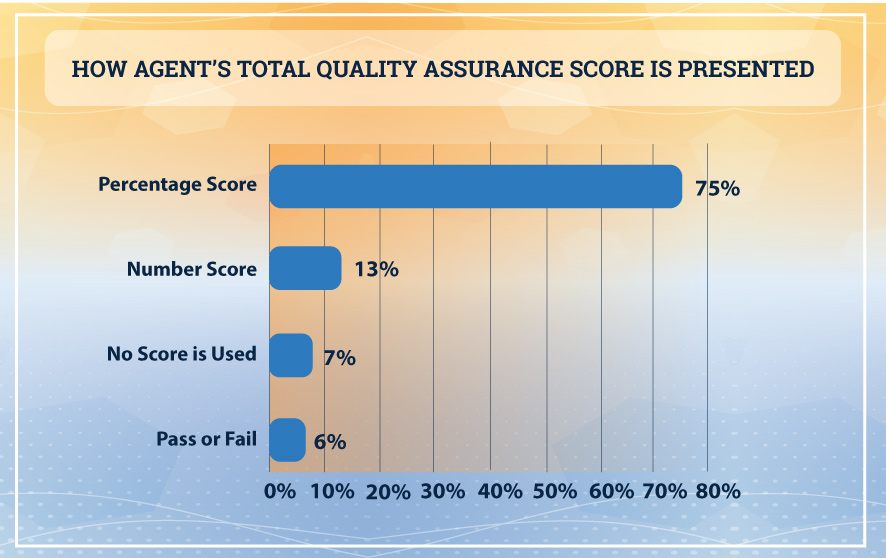
Furthermore, there are many different scale choices (e.g., binary – yes or no, Likert –4 or 5 point Csat rating, and 3 to 5 point scales). So which scale is the best option for your call center? In most cases, the best scale choice is to use a combination of scales. For example, the customer survey uses a 4 or 5-point satisfaction scale for measuring agent customer service delivery, and for call compliance metrics, it is common to use a binary scale where you can say yes or no and 3 to 5-point scales when the metric is more subjective.
In addition, for customer service QA scoring to be effective, we recommend using multiple data evaluation methods. Multiple data methods allow for the use of 360-degree feedback for conducting a customer service QA review for agents to understand their strengths and weaknesses based on evaluating a specific call from multi-raters (e.g., customers, QA evaluators, and artificial intelligence) feedback. Furthermore, 360-degree feedback widens the lens and reduces supervisor bias, providing a clearer picture of an agent's strengths and weaknesses for the supervisor coaching agents to improve CX.
Customer Service QA Evaluation Form
Below is a customer service QA form scoring breakdown of potential metrics to be included in a customer service QA evaluation scorecard. In addition, below, you can download a customer service QA evaluation scorecard form template that many SQM clients use to improve their FCR and Csat performance while at the same time achieving call compliance requirements.
Customer Service QA Form Scoring Breakdown
- 60 points are available based on customer survey results, and 40 points are available based on call compliance metrics.
- For the 60 points allocated for customer survey results, 30 are for call resolution, 20 for customer satisfaction, and 10 for positive customer experience.
- For the 40 points allocated for call compliance metrics, 31 are customer-focused, and 9 are organization-focused.
- Customer service QA point allocation is 91% skewed towards customer metrics (i.e., 60 points from the customer survey metrics and 31 points from call compliance metrics).
- Having 91% of the customer service QA evaluation form allocated towards the customer's experience sends the message to agents that the customer's experience (e.g., call resolution, Csat) is what really matters in the customer service QA evaluation program and to the organization.
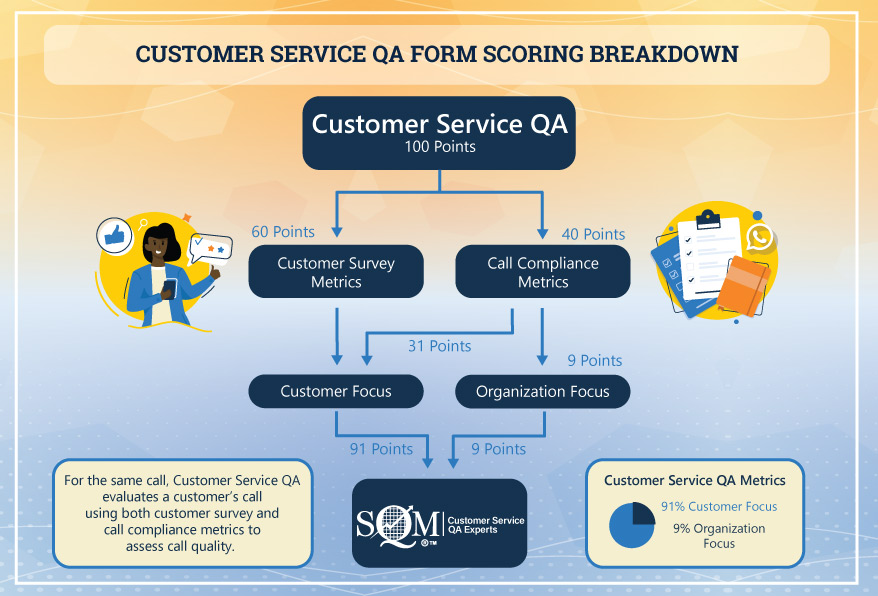
How To Create a Customer Service QA Scorecard
The below information is designed to help call centers create a customer service QA scorecard to deliver great CX. A customer service scorecard is used to evaluate and score agents on behaviors and skills related to customer experience and call compliance metrics.
Each customer call presents a unique situation and requires an agent to adapt. An effective QA scorecard will empower your agents to deliver great customer service for every customer situation.
The customer service QA scorecard uses a grading rubric for your agents to understand their performance and coaching opportunities to improve. If an agent meets all the customer service QA criteria on the scorecard, they have successfully delivered good or great CX.
Customer service QA scorecard provides outstanding CX insights and value to your call center. Agents can successfully deliver great customer service when they have the right guidelines and metrics in their QA scorecards. When the right QA metrics and guidelines are in place and agents follow them, FCR and Csat will improve.
When a call center uses the right QA guidelines and metrics, agents appreciate using the QA scorecard because it identifies strengths to build on and weaknesses to develop. Therefore, in many cases, they get high customer service QA scores when they follow the guidelines and standards.
Furthermore, if agents meet the criteria of the QA scorecard, they know what is expected of them and how to achieve it, which creates job satisfaction and reduces anxiety and stress.
Customer Service QA Scorecard Detailed-Level Breakdown:
- Below are the standard customer service QA evaluation metrics, data evaluation method, and point allocation weighting we use with our clients. The customer service QA metrics and point allocation should be used as a guide for developing a customer service QA evaluation form and scorecard appropriate for your call center.
- The customer service QA form consists of customer experience and call compliance sections with corresponding sub-sections. The customer service QA form total points available is 100 points.
- A five-point scale is used to determine the total customer service QA scoring range (i.e., Great: 100 Points, Good: 90-99, Average: 70-89, Needs Improvement: 50-69 & Unacceptable: 0-49).
- The customer service QA form has four critical error metrics (i.e., call resolved, accurate information, verified call access & correct fees). If an agent makes a critical error in these metrics, they receive 0 points for their entire customer service QA Evaluation.
- The customer service QA evaluation form is comprised of the following metrics, data evaluation method, point allocation weighting, and scoring range:
How Should Customer Service QA Scorecard Data Be Used?
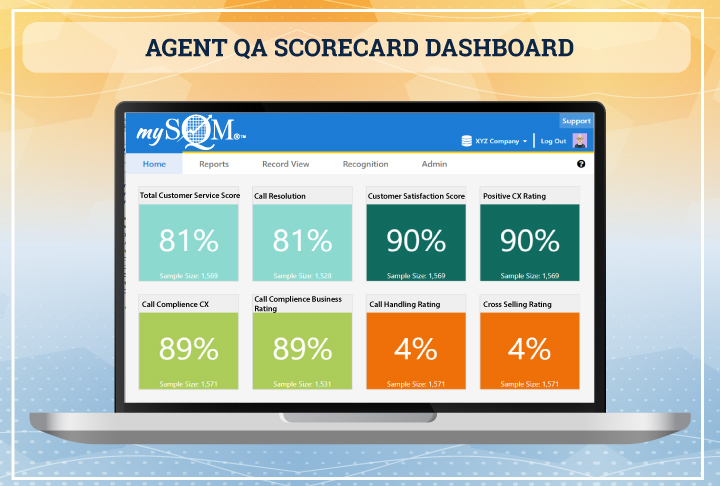
Firstly, you need to make sure that agents can view their customer service QA data in real-time in an easily understood QA scorecard dashboard. In many cases, agents improve their QA performance by viewing the QA dashboard performance and benchmarking their performance to other agents on their team or call center.
In addition, supervisors should be able to view agent QA scorecard performance to benchmark them to other agents, understand trends for key QA metrics, identification of strengths to build on and weaknesses to coach agents on behaviors and skills to improve.
To augment the agent QA scorecard dashboard, for each QA evaluation, agents need access to the detailed customer service QA evaluation scorecard that shows all the metrics, call recording, screen capture, and QA evaluator notes to view before being coached by their supervisor. When agents have access to the essential QA data, it puts them in a better position to understand their performance and leverage the coaching they receive from their supervisor.
Call centers should track QA metrics trends at the agent and team levels. For example, a supervisor or analyst can determine if coaching, policies, processes, and technology changes have impacted customer service by conducting a trend analysis.
Tracking agent QA scorecard performance for critical metrics will enable a supervisor to recognize agents who have performed at a high level for delivering great CX. In addition, supervisors will be able to identify agents whose CX performance is below the benchmark average and require additional coaching.
Quick Related Links
First Call Resolution Comprehensive Guide Customer Satisfaction Comprehensive Guide Agent Coaching Customer Quality Assurance Good to Great Customer Service

